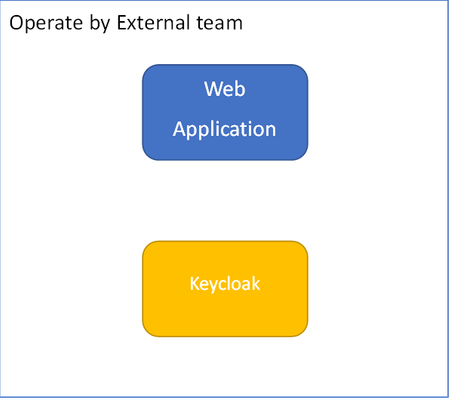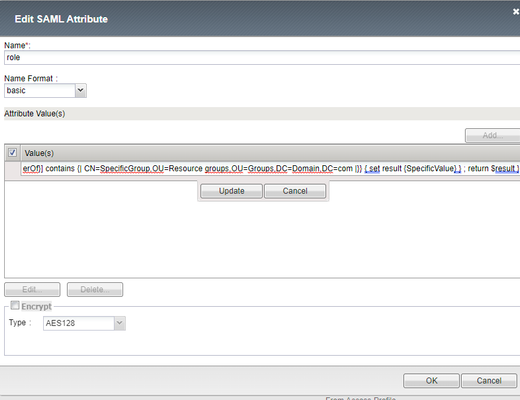idp
47 TopicsKeycloak as IDP for F5 APM via SAML
I have a requirement from our customer to do MFA authentication on F5 APM module and use Keycloak as Identity provider to control their access to web application. Since the keycloak is operate by different team, the internal operation team don’t have an authorize to do MFA on keycloak. They will use F5 APM to perform MFA instead. Existing environment. Solution Protect your web application by deploy F5 as web proxy. Configuration Import your SAML metadata to F5 APM Start by login to your keycloak console and downlond SAML metadata Make sure you have right realm selected. Save as you metadata Navigate to External IDP connector Create External IDP connector Upload your Metadata previously downloaded and name your SAML IDP connector Create your web.f5test.com certificate. Navigate to SSL Certificate list console Create your new certificate Configuration your parameter and click finish Create your Local SP Service Navigate to local SP service console Click create new SP service Input name, EntityID and SP name setting Config POST as assertion consumer service binding Configuration security setting with certificate generated earlier and click OK Binding your SP service with IDP connector Select your newly SP service created Add new row and select you IDP connector profile. Import your SP service to Keycloak Export your SP service Create new client on Keycloak Select file downloaded from previous section Click save4.8KViews0likes1CommentAPM Cookbook: SAML IdP Chaining
As an APM subject mater expert at F5 I often find myself in situations where a customer or colleague needs an example of a particular configuration. While most of these requests are easily handled with a call or WebEx I'm a firm believer in sharing knowledge through documentation.. and I don't like getting calls at 3 AM. If you're like me you grew up with the O'Reilly Cookbook series which served as a great reference document for various development or server configuration tasks. My goal is to create a similar reference resource here on DevCentral for those one-off scenarios where a visual example may help your complete your task. For the first APM Cookbook series I'll discuss SAML IdP chaining. Overview Security Assertion Markup Language, more commonly known as SAML, is a popular federated authentication method that provides web based single sign-on. One of the key security advantages to SAML is the reduction in username/password combinations that a user has remember... or in my experience as a security engineer the number of passwords written on a post-it note stuck to their monitor. There are two major services in a SAML environment: IdP - Identity Provider SP - Service Provider The identity provider is the SAML service that authenticates the user and passes an assertion to then service providers proving the user's identity. F5's APM performs both IdP and SP services and allows customers to easily deploy federated authentication in their environment. In more complex scenarios you may run across a requirement where multiple SAML IdPs need to be chained together. This comes up from time to time when customers have contractors that utilize federated authentication for authorization to corporate resources. Example For our configuration we have the Globex Corporation that uses APM to authenticate uses to Office 365. Globex hire contractors from Acme Corp. who authenticate using the Acme Corp. ADFS environment. However, since Office 365 is configured to authenticate against the Globex APM we need to convert the Acme Corp. SAML assertion into a Globex SAML assertion, which is known as IdP chaining. The step ladder for this process is shown below: 1. User requests https://outlook.com/globex.com 2 - 3. Office 365 redirects user to idp.globex.com 3 - 4. idp.globex.com determines user is a contractor and redirect user to sts.acme.com 5 - 8. User authenticates using Acme credentials and is then redirect back to idp.globex.com 9. idp.globex.com consumes the Acme SAML assertion and creates a Globex SAML assertion 10. User is redirected back to Office 365 11 - 12. Office 365 consumes the Globex SAML assertion and displays the user's mail Configuration To configure your APM SAML IdP to accept incoming assertion from sts.acme.com we need to create an external SP connector. Under the Access Policy -> SAML -> BIG-IP as SP configuration section: 1. Create a new SAML SP Service 2. Export the SP metadata and configure sts.acme.com accordingly (follow your IdP vendor's documentation) 3. Click the External IdP Connectors menu at the top 4. Click the dropdown arrow on the create button and choose From Metadata (import the metadata from sts.acme.com) 5. Bind the Local SP service to the external IdP connector Now that idp.globex.com and sts.acme.com are configured to trust one another we need to configure the APM IdP to consume the sts.acme.com SAML assertion. The IdP's Visual Policy Editor should look similar to the image below: 1. The Decision Box asks the user what company they're with. This is a simple example but more elaborate home realm discovery techniques can be used. 2. The SAML Auth box is configured to consume the sts.acme.com assertion 3. Since we no longer have a login form on the IdP we need to set a few APM session variables: session.logon.last.username = Session Variable session.saml.last.identity session.logon.last.logonname = Session Variable session.saml.last.identity 4. Create an Advanced Resource Assign that matches your existing IdP Advance Resource Assign. Conclusion This particular post was a little longwinded due to the steps required but overall is a fairly simple configuration. So the next time someone asks if your F5 can do IdP chaining you can confidently reply "Yes and I know how to do that".4.7KViews1like7CommentsInvalid Session ID. Your session may have expired - during kerberos auth
I have an IdP setup that is doing client side kerberos auth before then sending on a SAML token to an SP. I have an intermittant issue were sometimes using the kerberos auth It seems to fail and send me to a logout page with an error .../my.logout.php3?errorcode=20 Your session could not be established. The session reference number: 23f22713 Invalid Session ID. Your session may have expired. In the logs I can see: Session deleted (security_check). Sometimes the Kerberos is ok and sometimes not, any ideas where to look for the cause of this? Thanks2.6KViews0likes5CommentsSAML SP ACS Post back resulting in a 404
Hello, I have one application configured to use APM via SAML authentication, the SP & IdP are both running directly on our F5 - this setup is working for many applications only for this one i have problems with the SAML flow. So only some web ressources from this app are protected, we used here an iRule in order to handle this, when i access one of the protected URIs i will be redirected to our IdP in order to get the authentication (KRB Ticket), this is still working i get a session for it (Allowed state) and see also the correct SP in the reference. But the bost pack from Idp to the SP to the ACS /saml/sp/profile/post/acs is resulting in a 404 Accessing protected web ressource -> www.app1.com/protected No session right now so i will be redirected to Idp -> idp.com/saml/idp/profile/redirectorpost/sso (Post; State 302) Redirect back to SP -> www.app1.com/saml/sp/profile/post/acs (Post; State 404) Anybody an idea how to solve this or where i can start with the error search? Thanks, ChristophSolved2.4KViews0likes4CommentsHow to customise Azure AD OIDC user ID token for APM integration
Overview A Service Provider (SP) such as the F5 APM can integrate with Azure AD (AAD) as an Identity Provider (IDP) for federated authentication using OpenID Connect (OIDC). Through this process, a user visiting APM (e.g., https://myapps.acme.corp ) is immediately redirected to AAD for authentication, once authenticated, AAD returns a code to the APM via the user browser. The APM grabs that code, adds additional information, sends them together to AAD, and finally receives an ‘access_token’ and ‘id_token’. This article takes a special focus around what is included in ‘id_token’ that AAD returns, as it is used by APM, and broadly speaking by any relying party SP, for the purpose of session creation. ‘id_token’ (part of OIDC) contains user identity information and is highly customizable. The customization of ‘id_token’ is completely done within AAD. The concept is simple, but not until it is well understood in my experience; especially with the AAD having a bunch of configuration items in the mix, such as ‘Token configuration’, ‘API permissions’ and ‘Expose an API’. This article hopes to cut all the clutter and un-muddy the water so to speak, around this topic. OIDC As a refresher, the difference between oAuth and OIDC lies in that OIDC is an identity piece laying on top of oAuth. Specifically, with oAuth, ‘access_token’ alone is returned, whereas with OIDC, ‘id_token’ is returned in addition to ‘access_token’. Scope To tell AAD we are using OIDC, the APM needs to include a scope named ‘openid’ in its outbound request to the AAD. This is achieved via the following setting. Within AAD, your application must include ‘openid’, as shown below. By default, the ‘openid’ scope comes with a list of claims that will be included in ‘id_token’. However, for certain claims to be available, additional scopes are also required. For example, if you want to have ‘preferred_username’and ‘name’ claims included, ‘profile’ scope needs to be added as well, as is depicted in the following. AAD also lets you add optional claims via ‘Token configuration’ as shown below. If these optional claims need additional scopes, AAD will add those scopes in for you under ‘API permissions’. On the APM ‘OAuth Client’ configuration, make sure to add those scopes in as highlighted below. Once the APM matches scope with AAD, AAD will include all claims in ‘id_token’ it sends back to the APM. The APM is then able to consume those claims based on the use case (e.g., create a session using email) I am hoping that this short article sheds some light around your integration work around this space.1.7KViews2likes0CommentsAPM Create SAML Idp from META-data fails. MCP Error: 01070734:3
Hi, im running into a wierd problem. Im trying to import an external Idp connector from META-data. But im getting an error that i don't understand. I have tried to search in the forum and on the web for an answer but it seems like no one ever had this problem: "MCP Error: 01070734:3: Configuration error: apm aaa saml-idp-connector /Common/etj-ver : Signature verification failed. File contents changed" Anyone know what it means? Im guessing there is something wrong in the META-data but its quite hard to make anything out of this error message. The Idp have a wildcard certificate in it, could that be a problem for APM? Cheers // MattiasSolved1.5KViews0likes8CommentsSAML IdP - Can you have one APM support multiple SAML IdPs?
We have setup one vip and one APM that we want to use for all SAAS logins. We are currently federating with about four saas cloud vendors (Salesforce, box, and others). I don't want to create multiple virtual servers or APMs but for the APM you can only pick one SSO configuration. Each SAML IdP services shows up as it's own SSO configuration. Will I need to do an iRule to switch between them? Also in the documentation it says that you can have multiple IdP for a virtual server. Current Setup SAML IdP Connfiguration * IdP Services -> idp_salseforce (bound to sp connector) sp_connector_salesforce * IdP Services -> idp_box (bound to sp connector) sp_connector_box VirtualServer_SSO_SAML -> APM_SSO_SAML -> SSO Configuration -> Only allowed to pick one idp services (this is the problem)Solved1.5KViews0likes12CommentsAPM SAML IdP - SP Issuer Extraction
Problem this snippet solves: APM doesn't expose any detail about the SAML SP Issuer when authentication requests hitting APM as an IdP during an SP initiated SAMLRequest. This iRule when applied to a SAML IdP enabled virtual server will extract the assertion request, decode it and present the SAML SP Issuer ID as the session variable %{session.saml.request.issuer} within APM. How to use this snippet: This comes in real handy when performing authorisation of the resource and could help avoid having APM perform a TCP connection reset when a SAML resource isn't authorised. Code : when CLIENT_ACCEPTED { ACCESS::restrict_irule_events disable } when HTTP_REQUEST { if { [HTTP::path] equals "/saml/idp/profile/redirectorpost/sso" } { if { [HTTP::method] equals "POST" } { # Colelct POST data set content_length [HTTP::header value Content-Length] HTTP::collect $content_length } elseif { [HTTP::method] equals "GET" } { #TODO } } } when HTTP_REQUEST_DATA { set payload_data [URI::decode [HTTP::payload]] log local0. "payload=[URI::query "?$payload_data" "SAMLRequest"]" if { $payload_data contains "SAMLRequest" } { # Extract SAML request data set SAMLdata [b64decode [URI::query "?$payload_data" "SAMLRequest"]] set SAML_Issuer_loc [string first "saml:issuer" [string tolower $SAMLdata]] set SAML_Issuer_start [expr {[string first ">" $SAMLdata $SAML_Issuer_loc] + 1}] set SAML_Issuer_end [expr {[string first "<" $SAMLdata $SAML_Issuer_start] - 1}] set SAML_Issuer [string range $SAMLdata $SAML_Issuer_start $SAML_Issuer_end] if { !([ACCESS::session sid] equals "" ) } { ACCESS::session data set session.saml.request.issuer $SAML_Issuer } } } when ACCESS_SESSION_STARTED { if { [info exists SAML_Issuer] } { ACCESS::session data set session.saml.request.issuer $SAML_Issuer } } Tested this on version: 11.61.5KViews2likes7CommentsSAML Idp-Initiated Connections
I am new to the whole SAML thing and have been playing around with it. I have setup my saleforce dev account to work with our BigIp device and it works perfectly. Since I am still super new to this beg my forgiveness if I mix up any terms, and feel free to let me know. I setup a BigIP as Idp for SalesForce and configured all the settings in the Local Idp Service tab. I then created an External SP connector and connected the Service to that connector. I believe that this is SP-Initiated SAML correct? This allows me to use our AAA (AD) to login to SalesForce. Now I am playing with another vendor that only supports Idp-Initiated Connections. My question is how do I go about creating a Idp Initiated Connection to SP? Thanks!1.2KViews0likes20Commentstcl logic in SAML Attribute value field possible?
Hi. We're running BigIP as a SAML IDP. Can I somehow issue tcl logic in a SAML attributes? I'm talking about the Access ›› Federation : SAML Identity Provider : Local IdP Services, editing an object, under SAML Attributes. Based on what's in the memberOf attribute, I need to issue as a value either empty string or "SpecificValue". I am familiar with the %{session.variable} construct, but I don't want to clutter the session with more variables if I can avoid it, as that impacts all sessions using our IDP (30 or so federated services on the same VIP and AP). I tried these two approches: %{ set result {} ; if { [mcget {session.ad.last.attr.memberOf}] contains {| CN=SpecificGroup,OU=Resource groups,OU=Groups,DC=Domain,DC=com |}} { set result {SpecificValue} } ; return $result } expr { set result {} ; if { [mcget {session.ad.last.attr.memberOf}] contains {| CN=SpecificGroup,OU=Resource groups,OU=Groups,DC=Domain,DC=com |}} { set result {SpecificValue} } ; return $result } Expected result: An issued claim with the value "" or "SpecificValue" Actual result: An issued claim with the above code as the value As I mentioned, we've set it up using one VIP that is hosting 30 or so services. We're running 16.1.3.1. They are using the same SSO configuration and there's an iRule triggerd at ACCESS_POLICY_AGENT_EVENT, which does some magic to extract issuer and suchlike, and that helps to make decisions later in the Access Policy. It also populates a few session variables under the session.custom namespace for use in the Access Policy. Additional session variables are being populated in the Access Policy, such as resolved manager and their email address. I have looked briefly at the ASSERT::saml functions, but even if it would be possible to manipulate that way, I wish to keep this set up as stream lined as possible and with as few new "special cases" in an iRule. So while I appreciate pointers along that route as well, I would first of all like to know if there is a way to do it natively in the SAML attribute value field. And if there are any options I have not yet explored here?1.1KViews0likes6Comments



